Dominique Luchart's Blog, page 645
April 22, 2021
Brompton electric bikes recalled by US government over unexpected acceleration bug,
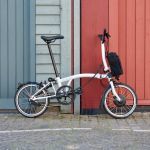
Hundreds of foldable electric bikes made by UK firm Brompton have been recalled for repair by the US government. A software fault is causing the bikes’ electric motors to deliver “forward momentum” when the rider is not pedaling. It’s an issue that poses “fall and injury hazards,” according to the US Consumer Product Safety Commission (CPSC), but can be remedied by a free software upgrade performed at certain Brompton dealers.
The problem affects roughly 600 bikes sold by Brompton’s US dealers between June 2020 and March 2021, with the bicycles themselves retailing for between $3,500 and $3,800.
Owners can check if their bike is one of those affected by entering the product’s serial number (found on a sticker on the frame) into a tool on Brompton’s website. If necessary, they can head to a Brompton dealer to get the firmware upgrade. Anyone affected can apply for a $30 credit voucher provided by Brompton “as a gesture of goodwill.” Presumably this voucher can only be redeemed at Brompton’s online store, where you can find a range of sensible biking wear and leather accessories specially designed for commuting fetishists.
Although unwanted acceleration is pretty high on any company’s list of “software oopsies we don’t want affecting our electric vehicle,” Brompton says the actual danger posed by the issue is extremely low.
“Under specific circumstances if a system failure occurs, there is a low possibility that the electric system may continue to provide assistance to the motor, causing continued forward momentum, when the rider is not actively pedalling,” said the company in a statement on its website. “The risk of an accident occurring is very low with only one reported minor fault, which did not result in any injury or accident.”
If you want to hear this same message delivered in soothing tones by Brompton’s chief design and engineer officer Will Carleysmith, you can watch the video on the issue below:
[embedded content]Brompton’s folding bicycles have achieved something of a cult status among a certain sort of nerdy and affluent urban commuter. However, a combination of Brexit and COVID have hit the company’s manufacturing operations hard, causing material shortages and rising production costs. A recall is hardly good news in such a tricky business environment.
In our review of Brompton’s most recent folding electric bike (unaffected by the software issues that prompted this week’s recall) we found it to be extraordinarily adaptable thanks its folding design but lacking in comfort needed for longer commutes.
The post Brompton electric bikes recalled by US government over unexpected acceleration bug, appeared first on NEWDAWN Blog.
New Touch ID Magic Keyboards work with all M1 Macs, not just the iMac,
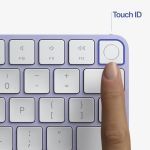
The Touch ID sensor in Apple’s new Magic Keyboard, which debuted alongside the updated iMac earlier this week, works with any Mac fitted with Apple’s M1 processor, Rene Ritchie and MacRumors report. The catch is that, for now at least, the keyboard is only sold with the new M1-equipped iMac, which is available to preorder from April 30th.
Apple has been shipping MacBooks with built-in Touch ID for a while now, but this is the first time it’s been available in an accessory. The biometric security method can be used for logging into the device, as well as authorizing purchases and signing into some third-party apps. The new Touch ID keyboard is available with a compact layout, as well as a full size keyboard with a numpad.
You can only buy them with the M1 Mac (for now?) but you can use them (with Touch ID!) on other M1 Macs, or just as BT keyboards (no Touch ID) on Intel Macs/other devices. https://t.co/mOOp5mbmg2
— Rene Ritchie (@reneritchie)
The bad news for owners of older Macs is that the Touch ID functionality in the new keyboard won’t work with any Intel-based machines. The keyboard itself will reportedly function, just not the biometric security. As Apple’s press release explains, the new keyboard requires the Secure Enclave in the M1 processor to encrypt the transmitted fingerprint information end-to-end.
Although the Touch ID keyboard is currently only available with the new all-in-one, MacRumors notes that Apple has previously opened up exclusive accessories for general sale. For example, it started selling the gray keyboard, mouse, and trackpad for anyone to buy in 2018, after previously limiting them to the iMac Pro in 2017.
The post New Touch ID Magic Keyboards work with all M1 Macs, not just the iMac, appeared first on NEWDAWN Blog.
Joe Biden pledges to drastically slash US greenhouse gas emissions by 2030,

President Joe Biden announced a new goal to sharply cut down US greenhouse gas emissions this decade. The country’s new mandate is to reduce planet-heating gases by 50 to 52 percent of what the US emitted in 2005. It significantly ramps up a previous commitment under the Paris climate agreement made by former President Barack Obama, who pledged to slash emissions between 26 to 28 percent below 2005 levels by 2025.
The urgency for the US to gut its climate pollution has only grown since the Paris Agreement was adopted in 2015. Global carbon dioxide emissions need to drop by half this decade and reach close to zero by the middle of the century in order to hit the goals of the Paris Agreement and prevent some of the most devastating effects of climate change, a landmark 2018 report found. The US has a huge role to play as the second biggest greenhouse gas polluter after China. But it abdicated leadership on the climate front under former President Donald Trump, who briefly pulled the US out of the Paris accord and drastically rolled back environmental regulations in the US.
Now the US hopes to regain respect on the international stage when it comes to tackling the climate crisis. Biden will hold his own virtual summit on climate today (Earth Day) and tomorrow aimed at encouraging other countries to ratchet up their goals. All countries are expected to update their individual commitments to combating climate change ahead of a United Nations climate conference scheduled to take place in November.
“[The Biden administration is] very cognizant that the US as a credible actor and leader in this space really depends in large measure on having a really robust new target,” says Pete Ogden, vice president for energy, climate, and the environment at the United Nations Foundation.
Major environmental groups like Sierra Club have pushed the Biden administration to target a reduction of at least 50 percent. Hundreds of businesses, including Amazon, Apple, and General Motors, did also.
Michael Mann, a climate scientist at Pennsylvania State University, told the Associated Press that the 50 percent goal “is precisely what is needed … an actionable goal within the next decade that puts us on the path toward limiting warming below a catastrophic 1.5 degrees Celsius.? The Paris agreement seeks to stop global average temperatures from rising 1.5 degrees Celsius above preindustrial levels, a threshold that scientists project would lead to catastrophic effects.
Some progressive groups called for deeper emissions cuts, citing the US’s history of contributing more to the climate crisis than any other country. “There exists in my mind no possible ethically justifiable story in which the United States does not do more,” said Tom Athanasiou, executive director of the activist think tank EcoEquity, which is part of a network that has called on the US to reduce its emissions by at least 70 percent below 2005 levels this decade.
More countries are expected to ratchet up ambitions this week during Biden’s climate summit. The UK announced on April 20 that it plans to cut its greenhouse gas emissions by 78 percent compared to 1990 levels by the year 2035.
Those commitments couldn’t come any sooner as climate pollution continues to grow. After a temporary drop in planet-warming CO2 emissions during the pandemic, annual emissions this year are on course for the sharpest rise since 2010.
“This is a dire warning that the economic recovery from the Covid crisis is currently anything but sustainable for our climate,” Fatih Birol, executive director of the International Energy Agency, said in a statement about the new estimate for 2021 emissions. “Unless governments around the world move rapidly to start cutting emissions, we are likely to face an even worse situation in 2022.”
The post Joe Biden pledges to drastically slash US greenhouse gas emissions by 2030, appeared first on NEWDAWN Blog.
Tesla’s solar panels will soon only be sold in bundles with Powerwall,

Tesla’s solar products will soon only be sold together with the company’s Powerwall battery, CEO Elon Musk announced on Twitter. Integrating them into a single product will making installations easier and home backup more seamless during outages, according to Musk. The change will affect both Tesla’s Solar Panels (which sit on top of an existing roof), and Solar Roof (which replaces a home’s existing roof slats).
The new policy was announced just hours after Musk responded to a tweet from Ark Investment Management’s director of research Brett Winton, who had complained that his Tesla solar panels hadn’t generated any electricity since installation because he was waiting on his local utility company to approve the connection.
Solar power will feed exclusively to Powerwall. Powerwall will interface only between utility meter & house main breaker panel, enabling super simple install & seamless whole house backup during utility dropouts.
— Elon Musk (@elonmusk)
“Did you buy a Powerwall?” Musk tweeted at Winton, “Utility permission is required for flowing electricity back to grid, but usually not if stored in our battery.” Bloomberg notes that Ark Investment has been a big supporter of Tesla, and holds “significant stakes” in the company.
Did you buy a Powerwall? Utility permission is required for flowing electricity back to grid, but usually not if stored in our battery. This also enables 24/7 electricity security for your home.
Utility permission is still needed for when Powerwall is full & can stabilize grid.
— Elon Musk (@elonmusk)
Signs of Tesla’s intention to bundle its solar products with the Powerwall were reported last month by Elektrek, who spotted that the company was only accepting new Powerwall orders when combined with a Tesla solar panel project. Powerwall supply shortages were thought to be to blame for the shift, with demand and wait times increasing for the home battery solution. In the fourth quarter of 2020, Tesla installed 86 mega-watts (MW) of solar energy, a 59 percent increase compared to the same period the previous year.
Alongside the change, Musk announced an upcoming software update for the Powerwall, which he says will enable upwards of a 50 percent power increase depending on production date. The current Powerwall is rated to provide 5 kW of real power (7 kW peak) in North America, but in a tweet the CEO said that Tesla’s newest units can “probably” provide as much as 10kW continuous, and “double that in peak” under the right circumstances.
The changes come after Tesla faced criticism for substantially raising the prices of some of its solar products. Earlier this month one customer reported that the company had told them a $35,000 solar roof order would now cost them $75,000, while the price of the accompanying batteries would increase from $30,000 to $35,000.
The post Tesla’s solar panels will soon only be sold in bundles with Powerwall, appeared first on NEWDAWN Blog.
The best robot vacuum for 2021 – CNET,
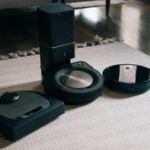
Is a sparkling clean floor one of your spring cleaning goals? If so, you don’t need a complicated chore wheel or cleaning schedule. And you can put the upright vacuum, broom, dust bin and mop back in the closet. We now live in the age of the smart vacuum, and there are robots to do that cleaning for us.
At one time, robot vacuums were only found in the pages of classic science fiction, or in Jetsons-like midcentury dream homes. That’s no longer the case. They’re real appliances. In fact, they’re far more advanced than ever before, with models boasting an array of sophisticated sensors, CPUs, lasers and even AI-enhanced software. The fact is that if you’re looking to keep your home nice and tidy, these robots are useful tools and will do the trick. Beyond dirt, a robot vacuum cleaner will pick up things like kitty litter and dust bunnies, keeping hardwood floor, tile floor, area rugs and carpets spick-and-span.
Nonetheless, living the robotic vacuum cleaner dream can set you back a hefty sum — some cost as much as four figures. While you don’t have to spend that much, you do get a lot in return. That includes self-emptying dust bins, multiple room and floor mapping, powerful suction and thoughtfully designed hardware.
Despite all this sophistication, however, none of these machines can really replace a mop and human exertion.
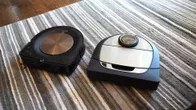
Now playing:
Watch this:
Battling bot vacs: iRobot Roomba S9 Plus vs. Neato Botvac…
8:07
To choose the best robot vacuum, I spent over 120 hours (that’s a lot of time) torture-testing a group of 12 robotic cleaning vacuums for things like suction power, their ability to perform on carpets and hard flooring, and how well they performed during each cleaning cycle. Among them are brand-new models that have recently launched, flagship models and compelling options offered across numerous online retailers. I excluded older models that likely won’t be sold for much longer. I’ll continue to update this list periodically as new models hit the market.
The best robot vacuum if you’re loadediRobot Roomba S9 Plus
Tyler Lizenby/CNET
If someone were to give you a blank check and tell you to buy the best robot vacuum, this is the bot to get. That said, the iRobot Roomba S9 Plus has a whopping price of $1,099. For that staggering pile of cash though, this robotic vacuum delivers powerful suction and superb dirt and dust removal.
On hardwood floors this Roomba picked up an average of 93% of our test sand, the highest amount in our test group, but it struggled a bit cleaning sand from low-pile carpeting and area rugs, earning a low average dust and sand pickup of 28%.
That said, the Roomba robot vac removed an average 71% of sand from our medium pile carpet while vacuuming. Again, this is the best result that we saw on this specific test. It also cleaned up more dog hair, pet dander and allergens than any vacuum in this test group, and the bot navigates and maps multiple rooms and floors. iRobot has also updated its app to let you designate “keep out zones” that you want the S9 Plus to avoid when cleaning. The app also lets you use voice commands to immediately clean a room using Alexa or Google Voice Assistant.
The robot zipped through our test room in a short average time of 25 minutes, too. You can link the S9 Plus to the Roomba app and your home Wi-Fi as well. Best of all is the Roomba S9 Plus’ CleanBase docking station. The dock both charges the robot’s battery and empties its dustbin automatically, making cleaning even easier and keeping you from worrying about battery life. Now that’s convenient.
Read our first impressions of the Roomba S9 Plus.
$899 at Amazon
The best midrange robot vacuumNeato D7
Tyler Lizenby/CNET
For less than half the price of the Roomba S9 Plus, the $500 Neato’s D7 vacuums up dirt, dust and messes almost as well, making it the best robot vacuum at a midrange cost. On average this robotic cleaner picked up a greater amount of sand (36%) across low-pile carpet and rugs than the Roomba did.
This automatic vacuum cleaner narrowly beat the S9 Plus for cleaning power on hardwood bare floors, too, collecting an average of 95% of the sand we put down. The vac cleaned dirt, dust and sand from midpile rugs less effectively though, notching a pickup average of 47% while cleaning.
While the Neato can’t match the Roomba’s prowess at removing pet hair or empty its own dust bin, the D7 navigates more efficiently around furniture yet covers more ground thanks to smart robot vacuum built-in lidar laser navigation mapping. You can also control the cleaning robot using the Neato app as a remote control, as well as link it to Amazon Alexa and Google Assistant. The app allows you to designate areas of your home as off-limits to cleaning, too.
$500 at Neato
The best robot vacuum valueEufy Robovac 11S Max
Tyler Lizenby/CNET
Here’s a robotic vacuum that proves you don’t need to blow your budget to purchase a solid robot vacuum cleaner. Even though the Robovac 11S Max costs just $170 right now, it cleans floors effectively. That’s especially true when cleaning bare hardwood floors.
It managed to remove an average of 71% of our test sand from this type of surface. The bot didn’t work as well cleaning carpets, earning sand-pickup averages of 21% and 27% on low-pile and mid-pile, respectively.
And thanks to this vacuum’s basic navigation system, it took well over an hour to negotiate our test room. As far as time goes, that’s a lot. Still, the Eufy used its runtime wisely. The vacuum covered the space well, cleaning up and leaving almost no spots untouched. The Eufy is also self-charging, so again, no need to worry about battery life or factor that into overall cleaning time. It’s the best robot vacuum for value.
$170 at Amazon
How we test robot vacuumsOur method for evaluating robot vacuums is straightforward, yet grueling. There are two types of tests we run. The first trial is to figure out how well a robot covers the floor while cleaning. We built an industry-standard testing room as specified by the International Electrotechnical Commission, just for this purpose. The IEC is an international standards body responsible for managing robot vacuum testing procedures, among other things, for vacuum manufacturers.
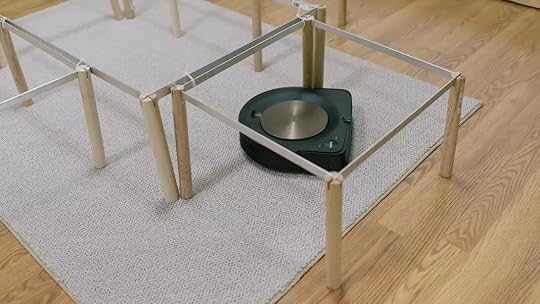 Enlarge ImageObstacles in our test room mimic what robot vacuums run into in the real world.
Enlarge ImageObstacles in our test room mimic what robot vacuums run into in the real world.Tyler Lizenby/CNET
Inside this room are objects designed to simulate typical obstacles a robot vac encounters for navigation as it cleans. These obstacles include wall edges, table and chair legs, couches and other furniture, and so on, plus bare tile and hardwood floors, as well as carpet.
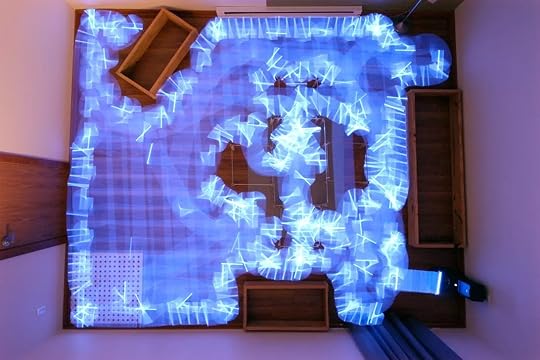 Enlarge ImageHere’s a coverage photo of the iRobot Roomba S9 Plus as it moved through our test room. You can see the Roomba S9 covered the floor well, except for one slight section in the center (left, bottom).
Enlarge ImageHere’s a coverage photo of the iRobot Roomba S9 Plus as it moved through our test room. You can see the Roomba S9 covered the floor well, except for one slight section in the center (left, bottom).Gianmarco Chumbe/CNET
We mount LED lights to the top of each vacuum cleaner. The dimensions of the lights correspond to the measured nozzle width of each particular robot vacuum we test.
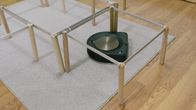
Now playing:
Watch this:
Lasers, sensors and robots, oh my: Some robot vacuums…
3:43
As robots move through the room while cleaning, a camera overhead captures a long-exposure image of the entire room in low light. That photo will then have a light trail, created by the LEDs, that shows the exact areas where the robot traveled (and its nozzle position) during its runtime. We can also see areas of the floor the vacuum may have missed or gotten stuck.
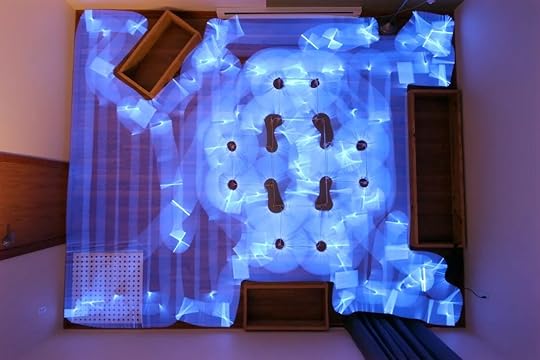 This is the coverage pattern created by the Neato D7. Its movement through our test room was very orderly, logical and effective.
This is the coverage pattern created by the Neato D7. Its movement through our test room was very orderly, logical and effective.Gianmarco Chumbe/CNET
You can see the navigation results of all the robot vacuums in our test group in the gallery below.
Some robot vacuums have a better sense of direction than others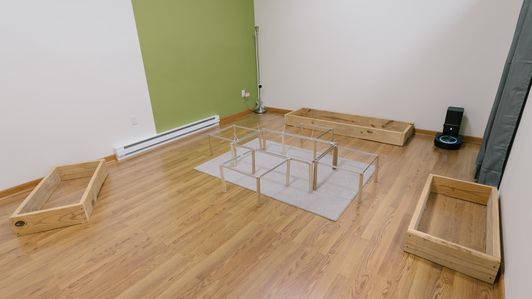
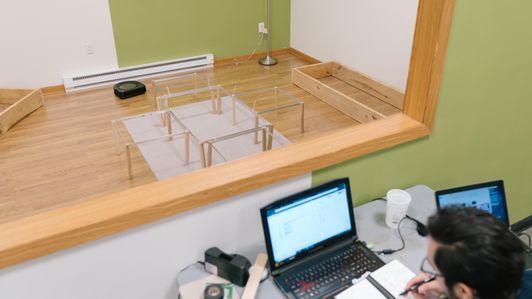
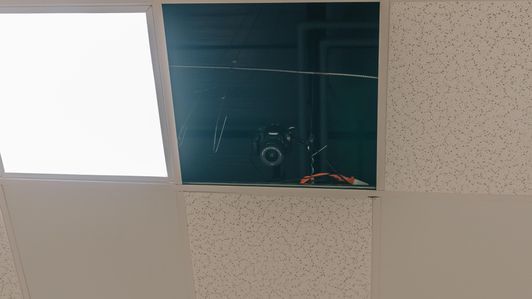
+12 More
The second type of test reveals exactly how much physical debris a vacuum is able to pick up off of the floor. To mimic dirt of small particle size, we use a mixture of play-sand and landscaping sand. For bigger particle soil, we use grains of uncooked black rice. Robots then run in straight line mode across three types of flooring (low-pile carpet, medium-pile carpet and hardwood bare floors).
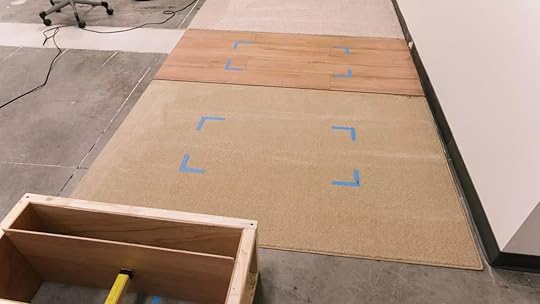 Enlarge ImageWe test robot vacuums on three types of floor surfaces.
Enlarge ImageWe test robot vacuums on three types of floor surfaces.Tyler Lizenby/CNET
We control for the specific nozzle width of each vacuum, too. We constructed an adjustable tool to soil our test floors. It lets us lay down a strip of precise area of soil to match the nozzle dimensions for every robot. The mass of soil isn’t chosen at random either. We measure a proportional amount that’s related to the flooring material, type of debris, plus each vacuum’s nozzle width.
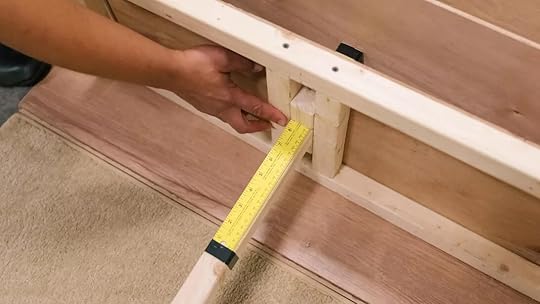 Enlarge ImageOur custom-built tool lets us match soil area to a robot vacuum’s nozzle width.
Enlarge ImageOur custom-built tool lets us match soil area to a robot vacuum’s nozzle width.Tyler Lizenby/CNET
We conduct three cleaning runs (at minimum) on each floor type. We also perform cleaning tests with sand and rice separately. That comes to at least 18 tests per robot vac. We weigh the robot’s dust bin both before and after each run. From there we can calculate the percentage of debris pickup for every cleaning run and the average amount of soil a machine manages to remove. Additionally we run anecdotal (visual) pet hair tests for each robot, on all three floor types.
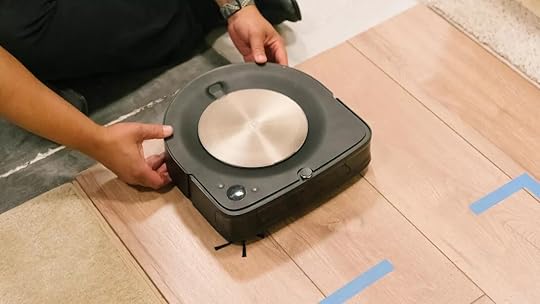 Enlarge ImageWe run robot vacuums in a straight line during the debris pickup tests.
Enlarge ImageWe run robot vacuums in a straight line during the debris pickup tests.Tyler Lizenby/CNET
The chart below shows the fine particle cleaning performance data for all of the robot vacuums we tested. It should give you a pretty good idea about their cleaning performance on different kinds of flooring surfaces. Our rice-based, medium-size particle test didn’t show enough differentiation between each cleaner, which says they can all handle larger particles without trouble. For fur removal for pet owners, we judged anecdotally.
Percent soil removediRobot Roomba S9 Plus
Neato D7
Neato D4
Electrolux Pure i9
Neato Botvac D6 Connected
RoboRock S5 Max
Ecovacs Deebot Ozmo 950
Shark IQ 1001AE
iRobot Roomba i7 Plus
Eufy RoboVac 11s Max
Ecovacs Deebot 600
Ecovacs Deebot 500
Legend:Sand from low-pile
Sand from hardwood
Sand from medium-pile
Note:
Results listed are the average percentage of total material removed from test surface
Want more robot vacuum options? Here’s a list of the other robot vacuums we tested besides the models listed above.
iRobot Roomba i7 Plus Neato D6Neato D4Electrolux Pure i9Shark IQ 1001AEEcovacs Deebot OZMO 950Ecovacs Deebot 600Ecovacs Deebot 500RoboRock S5 Max More vacuum advice and recommendations Your Roomba takes a weird path to clean the floors in your homeThe best cordless vacuums for 2021 iRobot Roomba 980: $550 for a high-end robot vacuumHow to prep your house so your robot vacuum won’t get stuckThe 10 best vacuums to use for kitchen cleanupiRobot Roomba S9 Plus vs. Neato Botvac D7 ConnectedVacuum Cleaners
The post The best robot vacuum for 2021 – CNET, appeared first on NEWDAWN Blog.
April 21, 2021
FBI used facial recognition to identify a Capitol rioter from his girlfriend’s Instagram posts,

The FBI says it used facial recognition technology to track down and arrest an individual suspected of taking part in the US Capitol riots earlier this year. The case, which was first reported by The Huffington Post, is notable for the FBI’s acknowledgement that it used facial recognition not just to confirm a suspect’s identity, but to discover it in the first place.
According to an affidavit shared online by the Huffington Post, federal agents tracked down an individual named Stephen Chase Randolph using crowdsourced images from the riots (including those shared on Twitter by a group known as SeditionHunters). They searched these pictures on the web using “an open source facial recognition tool, known to provide reliable results,” and this led to a public Instagram page apparently belonging to Randolph’s girlfriend which contained “numerous images” of the suspect.
 FBI agents found an Instagram page apparently belonging to Randolph’s girlfriend using “open source facial recognition.” Image: FBI Affidavit via
The Huffington Post
FBI agents found an Instagram page apparently belonging to Randolph’s girlfriend using “open source facial recognition.” Image: FBI Affidavit via
The Huffington Post
Pictures on the account showed Randolph wearing the same items of clothing as in stills captured at the Capitol. These included a grey knitted hat with the Carhartt logo embroidered in white on the front. This hat was key for tracking Randolph’s activities across multiple videos and images, leading to SeditionHunters dubbing him #GrayCarharttHat.
The FBI affidavit says Randolph was seen assaulting multiple US Capitol Police officers. “In the process of pushing the barricades to the ground, the SUBJECT and others knocked over a USCP Officer […] causing [her] head to hit the stairs behind her, resulting in loss of consciousness,” says the report. “The SUBJECT then continued to assault two other USCP officers by physically pushing, shoving, grabbing, and generally resisting the officers and interfering with their official duties of protecting the closed and restricted US Capitol grounds.”
After finding Randolph’s girlfriend’s Instagram account, federal agents found Facebook accounts apparently belonging to his family members, revealing Randolph’s full name. They then cross-referenced his identity with state driving license records and surveilled him at his home and workplace, where he was spotted still wearing the same Carhartt hat.
 The FBI tracked down Randolph to his workplace, where he was interviewed by undercover agents. Image: FBI Affidavit via
The Huffington Post
The FBI tracked down Randolph to his workplace, where he was interviewed by undercover agents. Image: FBI Affidavit via
The Huffington Post
To confirm Randolph’s participation in the riots, two undercover FBI agents approached him at his work on April 13. They struck up a conversation with Randolph in which he admitted to attending the riots, saying “I was in it” and “It was fucking fun.” Randolph also said he’d seen a female police officer being pushed over by the barricades, and suggested that the officer had suffered a concussion because she’d curled up into the fetal position. Randolph was arrested in Kentucky a week after this interview took place, says The Huffington Post.
The case shows how the FBI is using facial recognition and crowdsourced images to track down those who participated in the January 6 riots. Such tools are not always necessary to find suspects, but their use appears to be becoming increasingly common. A report from BuzzFeed News earlier this month revealed that some 1,803 publicly funded agencies, including local and state police, tested controversial facial recognition service Clearview AI prior to February 2020. The technology has only become more widely known since.
The post FBI used facial recognition to identify a Capitol rioter from his girlfriend’s Instagram posts, appeared first on NEWDAWN Blog.
FBI used facial recognition to identify a Capitol rioter from his girlfriend’s Instagram posts, James Vincent

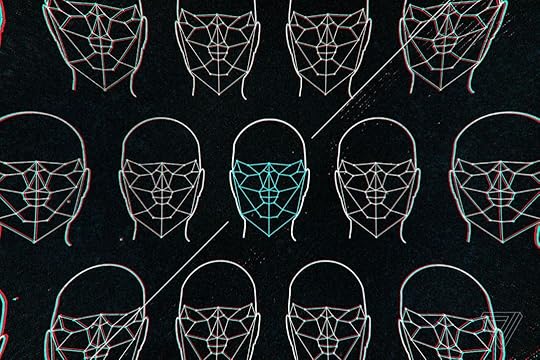 Illustration by Alex Castro / The Verge
Illustration by Alex Castro / The VergeThe FBI says it used facial recognition technology to track down and arrest an individual suspected of taking part in the US Capitol riots earlier this year. The case, which was first reported by The Huffington Post, is notable for the FBI’s acknowledgement that it used facial recognition not just to confirm a suspect’s identity, but to discover it in the first place.
According to an affidavit shared online by the Huffington Post, federal agents tracked down an individual named Stephen Chase Randolph using crowdsourced images from the riots (including those shared on Twitter by a group known as SeditionHunters). They searched these pictures on the web using “an open source facial recognition tool, known to provide reliable results,” and…
The post FBI used facial recognition to identify a Capitol rioter from his girlfriend’s Instagram posts, James Vincent appeared first on NEWDAWN Blog.
Any video conferencing app can use the iPad Pro’s fancy zoom and pan camera,
Apple has confirmed that the digital pan and zoom feature of the new M1 iPad Pro’s front-facing camera can work with any video conferencing app, not just FaceTime. That opens the door for popular apps like Zoom and Microsoft Teams to make remote work and e-learning blend more seamlessly into the realities of pandemic life — a hybrid lifestyle that’s likely to continue even after the outbreak subsides.
Center Stage, as Apple brands it, keeps video conferencing participants properly framed even as they move about a room by combining machine learning with a fixed 12-megapixel sensor touting an ultra-wide 122-degree field of view. We’ve seen similar tracking on the Portal TV, Echo Show 10, and even the Xbox Kinect accessory. But those are niche devices compared to the iPad, which saw sales surge last year as students and remote workers snapped the tablets up in droves.
“Center Stage works with FaceTime and other video conferencing apps,” says Apple on the iPad Pro landing page. Apple missed its chance to scale FaceTime to compete with the likes of Zoom and Teams by reneging on its promise to make it an industry standard in favor of ecosytem lock-in.
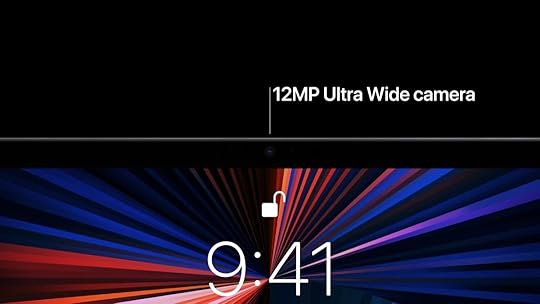 The ultra-wide front-facing camera is still located at the “top” of the new iPad Pro.Image: Apple
The ultra-wide front-facing camera is still located at the “top” of the new iPad Pro.Image: AppleApple demonstrated Center Stage with two participants, both of whom are recognized and framed appropriately as they move about a kitchen, on a FaceTime call with a third. It’s a good demo; the COVID-19 pandemic has blended work and life so hard that it’s now fairly common to see people making dinner during a Zoom meeting across international time zones, or a kid asking for a parent’s help during a Teams school lesson. Tech like Center Stage can help further infuse this sense of humanity into our otherwise stoic professional and educational pursuits.
Unfortunately, the position of the front-facing camera, even on the new M1 iPad Pro, makes participants appear to be staring off to the side when used with a keyboard dock, as is common for business and school uses. And iPadOS creates other frustrations for video conferences. Hopefully the iPad Pro is just a start and we’ll see ultra-wide Center Stage cameras coming to the much maligned, but better positioned, MacBook webcams soon.
The post Any video conferencing app can use the iPad Pro’s fancy zoom and pan camera, appeared first on NEWDAWN Blog.
Any video conferencing app can use the iPad Pro’s fancy zoom and pan camera, Thomas Ricker
Apple has confirmed that the digital pan and zoom feature of the new M1 iPad Pro’s front-facing camera can work with any video conferencing app, not just FaceTime. That opens the door for popular apps like Zoom and Microsoft Teams to make remote work and e-learning blend more seamlessly into the realities of pandemic life — a hybrid lifestyle that’s likely to continue even after the outbreak subsides.
Center Stage, as Apple brands it, keeps video conferencing participants properly framed even as they move about a room by combining machine learning with a fixed 12-megapixel sensor touting an ultra-wide 122‑degree field of view. We’ve seen similar tracking on the Portal TV, Echo Show 10, and even the Xbox Kinect accessory. But those are…
The post Any video conferencing app can use the iPad Pro’s fancy zoom and pan camera, Thomas Ricker appeared first on NEWDAWN Blog.
Gogoro is bringing its electric scooter and battery tech to India,
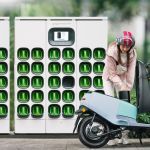
Gogoro is branching out of home country Taiwan in the biggest way yet, as it just announced a partnership with major two-wheeler manufacturer Hero MotorCorp to bring its swappable battery and scooter tech to India. As part of the deal, Hero will build electric scooters based around Gogoro’s tech, and will also install Gogoro’s battery-swapping stations in cities throughout the country.
Electric vehicles could help eat away at some of India’s pollution, and Tesla is even wading into the market. But building out charging infrastructure to handle passenger EVs is going to be a challenge for any company that wants to build a business there.
It’s a different story for scooters, and especially the ones made by Gogoro, which was founded by a pair of former HTC executives a decade ago. For one thing, electric scooters are smaller and draw less power. And Gogoro’s scooters are powered by swappable batteries that owners drop off and pick up at public stations the size of a typical vending machine.

Gogoro has spent the last few years encouraging industry giants like Yamaha and Suzuki to hasten the switch to electric power by striking deals with them to license its plug-and-play batteries. But the partnership with Hero is more involved, as the two companies will actually create a joint venture in India to make the scooters and build out the battery swap stations.
Gogoro also pitches its battery stations as a way to aid the local energy grid during times of peak demand. The company says it has installed 2,000 stations across Taiwan, which in total see about 265,000 daily battery swaps.
The popularity of electric two-wheelers is booming in China, and they’re starting to make big gains in other markets like Vietnam and South Korea. In comparison, they’re practically absent in India. Partnering with Hero is a way to quickly change that. The New Delhi-based manufacturer leads the world in units sold when it comes to motorcycles and scooters, and it has an extensive presence in India that goes far beyond the biggest cities.
“No other place on Earth has more people moving around on fossil fuel-burning two-wheelers than India,” Gogoro founder and CEO Horace Luke said in an interview with The Verge.
Two-wheeled vehicles account for an enormous amount of individual miles traveled in India, Luke said, and therefore are a huge source of gasoline consumption. And since Hero doesn’t currently have an electric scooter in its stable, Luke said the partnership could make a huge dent.
“It has been a very, I would say, challenging, challenging endeavor for [Hero] because they’re missing the infrastructure part of the equation,” he said. “They don’t have a battery swapping infrastructure that has proven to be solid enough for India to to transform and electrify their nation.”
Partnering with Hero made more sense than trying to break into India solo, Luke said, because trying to replicate the dealerships and presence the Indian manufacturer has built out over decades would be “moronic.”
“I would never try replicate that. It would kill me. I would be too old by the time I’d get even near that,” he said. “We need to play to the strength of the partner locally and enable them through our technology to let them win and go faster.”
Gogoro has dabbled in other markets in the past, but pretty much only as a provider for scooter-sharing services like Coup in Germany and France. The partnership with Hero, then, represents a new way for Gogoro to pollenate the world with its electric scooter tech — something that’s been a goal since it came out of stealth mode at the 2015 Consumer Electronics Show.
The post Gogoro is bringing its electric scooter and battery tech to India, appeared first on NEWDAWN Blog.



